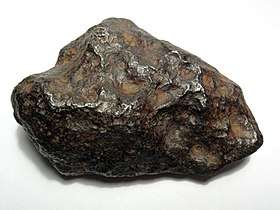Iron Man (Buddhist statue)
The Iron Man statue is a 24 centimetres (9.4 in), 10 kilograms (22 lb) sculpture depicting what could be the Buddhist deity Vaiśravaṇa that may be made from a rare ataxite class nickel-rich iron meteorite. It is claimed to be Tibetan and to have been carved circa 1000 CE, from a meteorite that fell to Earth approximately 15,000 years ago, although no evidence for this claim has been provided.
| Iron Man | |
|---|---|
| Year | c. 1,000 CE |
| Type | Sculpture |
| Medium | Ataxite class nickel-rich iron meteorite |
| Subject | Probably the Buddhist deity Vaiśravaṇa |
| Dimensions | 24 cm (9.4 in); Weight 10 kilograms (22 lb) |
Albeit claims that the statue may have been acquired by the 1938–1939 German expedition to Tibet, evidence of the statue's provenance has not been presented to date. The statue was kept in a private collection in Germany until it is said to have been auctioned in 2007. The figure is adorned with a counterclockwise-rotation Buddhist swastika.
Analysis

The material has been dated to the time of the Chinga meteorite, which fell near eastern Siberia and Mongolia between 10,000 and 20,000 years ago. The researcher who had determined the statue's composition has said, "If we are right that it was made in the Bon culture in the eleventh century, it is absolutely priceless and absolutely unique worldwide."[1][2]
Controversy
General features on the statue still raise doubts about its true nature and origin.[3] There are doubts that this statue was created in Tibet or that it could be related to Buddhist beliefs. Even the authors of the meteorite theory express several concerns and remark that their assessment of it being carved in the eleventh century is mere speculation.[4] On what relates to Schaefer expedition, as yet, there are no clear and independent references linking this statue to it. The authors of the article on the meteoric origin of the iron just state, "to our knowledge".
Some suspect this is a well elaborated forgery, specially when comparing features on cloth and the supposed deity it represents.
After initial hype, several media noted that this statue is not present on the list of items brought to Germany by the expedition, which is deemed to be "very precise".[5][6]
If the statue is somehow genuine, the nearest possible resemblance to a national dress would be Scythian. Not all details fit such resemblance, however, such as the remarkable double sleeved coat that fails to be associated with examples of Scythian clothing and the distinctive cut cuff of the pant legs. It shall be noted that certain groups of Scythians (Indo-Scythians/Sakas 200BC-400CE) were influenced by Buddhism and their kingdoms bordered modern Tibet on the west. While the last remains of a Scythian state vanished in the fifth century, pockets, in the form of tribes, may have survived in the Himalayas up to the tenth century. This may go well with assumptions made about the possible date of the statue's carving and even give ground to the hypothesis on the origin of primary material, but, with all contradictory features and the vague details of its "discovery", it is hard to accept this object as anything more than a source for wild speculations.
A photograph of the statue is published with a Science Daily article that discusses the statue without any mention of the controversy.[7]
See also
- Glossary of meteoritics
- Thokcha, the Tibetan use of meteorite metal in ritual objects
References
- Taylor, Mark (28 September 2012). "Priceless Tibetan Buddha statue looted by Nazis was carved from meteorite". The Guardian. Retrieved 1 January 2013.
- McGrath, Matt (28 September 2012). "Ancient statue discovered by Nazis is made from meteorite". BBC News. Retrieved 1 January 2013.
- Bayer, Achim. "The Lama Wearing Trousers: Notes on an Iron Statue in a German Private Collection" (PDF). Seoul, South Korea. Archived from the original (PDF) on 2012-10-18.
- Buchner, Elmar; Schmieder, Martin; Kurat, Gero; Brandstätter, Franz; Kramar, Utz; Ntaflos, Theo; Kröchert, Jörg (1 September 2012). "Buddha from space-An ancient object of art made of a Chinga iron meteorite fragment*". Meteoritics & Planetary Science. 47 (9): 1491–1501. Bibcode:2012M&PS...47.1491B. doi:10.1111/j.1945-5100.2012.01409.x.
- Davies, Lizzy (24 October 2012). "Nazi buddha from space might be fake". The Guardian. Retrieved 7 February 2013.
- Weber, Nina (23 October 2012). "Meteorite Nazi Buddha Exposed as Likely Fake". Spiegel Online. Retrieved 1 January 2013.
- Ancient Buddhist Statue Made of Meteorite, New Study Reveals, , Science Daily, September 26, 2012